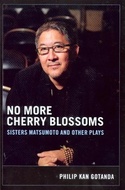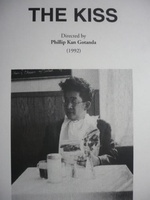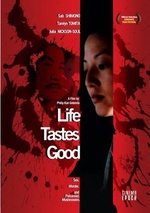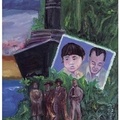>>その3
今回のコラムで私が取り上げたゴタンダの戯曲は、すべて『Fish Head Soup and Other Plays』と『No More Cherry Blossoms(桜の花はもういらない)』という2冊の戯曲集に収められている。後者には、「Sisters Masumoto」や「Natalie Wood is dead」を含めて4つの戯曲が収録されているが、どれも女性が主人公である。桜は美しさの象徴でもあるが、女性は従順であればよいという東洋の伝統世界を連想させるものでもある。それからの決別を示したタイトルにゴタンダの意図が読み取れる。
各戯曲には、初演の配役や演出家の名前も記されており、配役を見ると、ゴタンダはどの作品でも、必ずしも日系人の役者を使わない。韓国系や中国系の役者も好んで使う。それについて、一度彼に聞いたことがある。
「今の日系4世、5世はまるっきりアメリカ人で日系の歴史に関心がない。韓国系の若者は今2世なので、彼らのほうが日系2世の経験をより的確に表現できる」
この彼の答は大変興味深いものだった。ゴタンダが戯曲で描いている世界は日系社会だが、舞台で演じられている世界はアジア系アメリカ社会なのだ。
映画でもテーマは、人と人のつながり
ゴタンダはこれまで、「The Kiss(1992)」「Drinking Tea(1996)」「Life Tastes Good(1999)」という3作品の監督を務めており、「The Kiss」と「Life Tastes Good」では出演もしている。もともとミュージシャンとして人前で演じることに慣れているゴタンダだから、演技も堂に入ったものだ。
「The Kiss(ザ・キス)」は、まわりからいじめられているサラリーマン、ウィルフレッド・フナイが主人公。同僚から仕事を押し付けられ、昼食のサンドイッチには女性の下着が挟まれている。仕方なく昼食をとりにレストランに入ると、そこに一人のエイズ患者がいた。その患者が呼吸困難で倒れる。まわりが動揺し手をこまねいている中、フナイは毅然として立ち上がり、口移しで人工呼吸を行い、その男の命を救う。会社に戻ったフナイは、自分をいじめている同僚に言う。
「ぼくは人の命を救った」。役者たちの台詞を極限にまで少なくした13分の短編映画で、フナイの台詞はこれのみ。何かが変わろうとしている一人の男の内面を描いた作品だ。
「Drinking Tea(お茶を飲む)」は、息子を亡くした日系アメリカ人夫婦を描いている。主人公のカン・オガワは、メアリーと50年近く寄り添っているが、息子の死の責任はメアリーあるとずっと妻を責めていた。カンには恋人がいたが、恋人の死に直面し、メアリーのもとに帰ってくる。カンも長らく病気を患っており、最後を看取ってほしいと妻に頼む。自分の死を意識してはじめてカンは人生の辛さや苦さを理解し、息子の死が妻の責任でないことを認める。タイトルのお茶は、人生の苦さの象徴として用いられている。
「Life Tastes Good(人生はいい味)」は、犯罪絡みの金を動かしていたハリー・サドという男の物語である。その金をめぐって仲間のジョーンズと揉め、ハリーは倉庫に隠れて生活している。余命いくばくもないハリーは、それまで関係を断ち切っていた子供たちとの関係を修復しようとする。また、その倉庫で、ある白人女性と親密になる。死を間近にして人生の意味に気づき、ハリーは「人生はいい味」とその女性に呟く。このあたりは、「Drinking Tea」と通ずるものがある。
「Life Tastes Good」は、ゴタンダにとって初の本格的な長編映画で、1999年にサンダンス映画祭で上映された。私が見たのは、同年3月に行われたサンフランシスコ・アジア系アメリカ映画祭においてだったが、サンダンスでの上映が終わったばかりで、ゴタンダが興奮冷めやらぬ様子で舞台挨拶をしていたことを、今でもよく覚えている。
余談だが、今、コカコーラ社が'Life Tastes Good'という言葉を宣伝文句として使用している。ゴタンダは自身のウェブサイトでこんな風に書いている。
「全く信じられないけど、コカコーラが宣伝で大々的にこの文句を使っている。俺たちの映画のタイトルだってこと、知らないのかい? 俺たちが最初に使ったんだぜ」
「ザ・キス」や「人生はいい味」は、とくに日系アメリカ人を意識した物語ではないし、自立した力強い女性を描いているわけでもない。でも、人と人との関係、人間の絆を描いている点では他の作品と共通している。ゴタンダは戯曲でも映画でもさまざまな試みをしているが、作品を通して一番描きたいのは、まさにこの点なのではないか。人と人がどうつながっているのか、どんな絆で結ばれるべきなのか。映画ではそんな大きなテーマが扱われている。
いつか日本人とアメリカ人の物語を
2001年にゴタンダは、30余年ぶりに訪日している。もう自分探しの旅ではない。特別なつながりを感じている国を訪れる旅だった。心の奥底で日本とつながっている、と彼はいう。2003年、2004年と彼の戯曲が日本で上演されたときにも来日し、日本語版公演を鑑賞している。アメリカでの公演では、観客にさまざまな人種がおり、反応もさまざまだが、日本では皆が同じように反応する。それは、ゴタンダにとって新鮮な発見だった。
2006年、彼は国際交流基金日米センターと外務省が共催している「日系アメリカ人リーダーシップ・プログラム」に参加した。パネリストの一人として彼は次のように発言している。
「日本人とアメリカ人がどうしたら協力しあうことができるかを描いた物語をつくりたい」
是非、実現させてほしいものである。
(敬称略)
※本文中に引用した詩・エッセイの翻訳はすべて筆者による。
参考資料
『イエローフェイス』 村上由見子 朝日新聞社 1993
『駆け落ち 元トップモデル渥美延の選択』 吉村俊作 東京新聞出版局 1998
Asian American Culture on Stage, Yuko Kurahashi, Garland Publishing, 1999
Identity Politics of Asian American Drama; the theoretical landscape of Philip Kan Gotanda and Velina Hasu Houston 貴志雅之 「大阪外国語大学英米研究26」 2002
『日系アメリカ人リーダシップ・シンポジウム 芸術からビジネスまで:多様な職業を通じた日系アメリカ人の貢献』 国際交流基金日米センター 2006
『アジア系アメリカ演劇』 山本秀行 世界思想社 2008
参考ウェブサイト
http://www.philipkangotanda.com/
1999年11月に立ち上げられた本人によるウェブサイト。Floating Weeds, Joe Ozuなどのコラムがあり、ゴタンダの演劇・映画に関する活動、評論、戯曲の草稿、詩、などが精力的に書き込まれているが、この2年ほど、更新されていない。Floating Weeds(浮草)は、同名の戯曲もあり、本人の人生観を示しているように思われる。ジョー・オズは、Day Standing on its Headと、In the Dominion of Night に登場する人物で、彼のメールアドレスにもこの名前が使われている。オズは、彼が敬愛する映画監督、小津安二郎からとったもので、ジョーは、アメリカの肉体労働者の典型的な名前からとった。ジョーは、これ以上縮められない名前で、基本に戻る、という意味も付与されている。また、この名前を続けて発音すると、日本語の「上手」になるという洒落も含まれている。
*本稿は、時事的な問題や日々の話題と新書を関連づけた記事や、毎月のベストセラー、新刊の批評コラムなど新書に関する情報を掲載する連想出版 のWebマガジン「風」 のコラムシリーズ『二つの国の視点から』第5回目からの転載です。
© 2009 Association Press and Tatsuya Sudo









